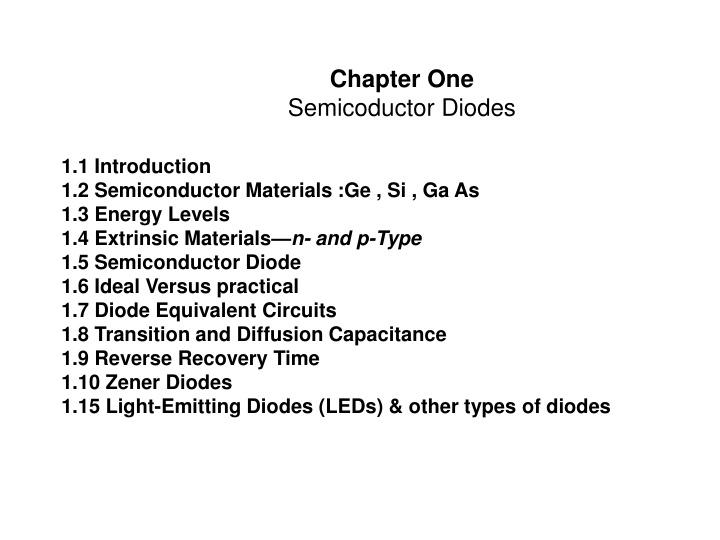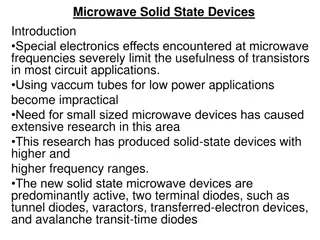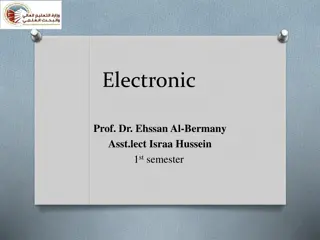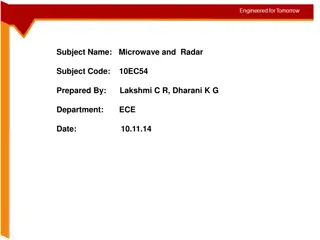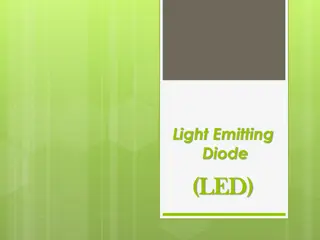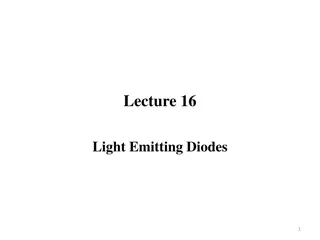Semiconductor Diodes: Materials, Energy Levels, and Applications
Semiconductor diodes play a crucial role in modern electronics, utilizing materials like Ge, Si, GaAs with specific energy levels. Understand intrinsic and extrinsic properties, ideal vs. practical behaviors, and applications including Zener diodes and LEDs. Explore the unique characteristics of semiconductor materials and their energy levels.
Download Presentation

Please find below an Image/Link to download the presentation.
The content on the website is provided AS IS for your information and personal use only. It may not be sold, licensed, or shared on other websites without obtaining consent from the author.If you encounter any issues during the download, it is possible that the publisher has removed the file from their server.
You are allowed to download the files provided on this website for personal or commercial use, subject to the condition that they are used lawfully. All files are the property of their respective owners.
The content on the website is provided AS IS for your information and personal use only. It may not be sold, licensed, or shared on other websites without obtaining consent from the author.
E N D
Presentation Transcript
Chapter One Semicoductor Diodes 1.1 Introduction 1.2 Semiconductor Materials :Ge , Si , Ga As 1.3 Energy Levels 1.4 Extrinsic Materials n- and p-Type 1.5 Semiconductor Diode 1.6 Ideal Versus practical 1.7 Diode Equivalent Circuits 1.8 Transition and Diffusion Capacitance 1.9 Reverse Recovery Time 1.10 Zener Diodes 1.15 Light-Emitting Diodes (LEDs) & other types of diodes
1. Semiconductor Diodes The miniaturization that has resulted leaves us to wonder about its limits. Complete systems now appear on wafers thousands of times smaller than the single element of earlier networks. The first integrated circuit (IC) working at Texas instrument in 1958 Today, the intel Pentium 4 processor has more than 42 million transistors. The first device to be introduced here is the simplest of all electronic devices, yet has a range of applications that seems endless. 2. Semiconductor Materials :Ge , Si , Ga As : The term conductor is applied to any material that will support a generous flow of charge when a voltage source of limited magnitude is applied across its terminals. An insulator is a material that offers a very low level of conductivity under pressure from an applied voltage source. A semiconductor, therefore, is a material that has a conductivity level somewhere between the extremes of an insulator and a conductor. As indicated by Fig. 1a, the germanium atom has 32 orbiting electrons, while silicon has 14 orbiting electrons. In each case, there are 4 electrons in the outermost(valence) shell.
The potential (ionization potential) required to remove any one of these 4 valence electrons is lower than that required for any other electron in the structure. In a pure germanium or silicon crystal these 4 valence electrons are bonded to 4 adjoining atoms, as shown in Fig. 2 for silicon. Both Ge and Si are referred to as tetravalent atoms because they each have four valence electrons. A bonding of atoms, strengthened by the sharing of electrons, is called covalent bonding Figure 1 Atomic structure: (a) germanium; (b) silicon. Figure 2 Covalent bonding of the silicon Atom
Intrinsic materials are those semiconductors that have been carefully refined to reduce the impurities to a very low level essentially as pure as can be made available through modern technology. An increase in temperature of a semiconductor can result in a substantial increase in the number of free electrons in the material. Semiconductor materials such as Ge and Si that show a reduction in resistance with increase in temperature are said to have a negative temperature coefficient. 3. ENERGY LEVELS: In the isolated atomic structure there are discrete (individual) energy levels associated with each orbiting electron, as shown in Fig. 3a. Each material will, in fact, have its own set of permissible energy levels for the electrons in its atomic structure. The more distant the electron from the nucleus, the higher the energy state, and any electron that has left its parent atom has a higher energy state than any electron in the atomic structure.
